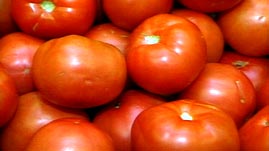Do you want to eat plants whose genes have been manipulated? If not, you should avoid eating produce! Crop plant genes have been mixed and matched by farmers for thousands of years. Assyrian carvings dating back to around 900 B.C. clearly depict the act of plant cross-pollination. Around the same time, Central American farmers were selectively breeding a variety of crop plants, especially corn.
For corn that is sweet, potatoes that are non-toxic -- all crop plants, in fact -- you have genetic manipulation to thank. And selective breeding is really just a primitive form of genetic manipulation. When a breeder chooses a male plant and a female plant for breeding, what he or she is really doing is choosing specific genes to combine from those two plants. By hand-delivering pollen (sperm) from the male plant to the female flower (which produces the egg), the breeder intervenes in the natural fertilization process to ensure that traits from the two "best" plants get passed on to their offspring. It's like an arranged marriage for plants.
But selective breeding is both imprecise and inefficient. Thousands of genes combine at once, and the offspring plant may not receive the exact combination of genes the breeder had intended. The breeder has no way of knowing whether the desirable genes are in the sperm and egg; one can only guess, based on the parent plants' appearance. Many offspring may need to be produced in order to get one with the desirable trait. So genetic manipulation through selective breeding is a slow process of trial and error.
Genetic engineering, however, is a targeted approach that allows scientists to remove specific genes from one organism and insert them into another. The gene recipient is called a genetically modified organism, or GMO (also called a "transgenic"). This efficient technique is also remarkable because it allows genes to be transferred between
different species, for example, between a flounder and a strawberry. Classical breeding could never achieve such a thing, since it requires the parent organisms to be of the same species.
As genetic engineering techniques improve, more and more GMOs are being grown and put on grocery store shelves. And while the GM food industry touts the benefits of genetic modification, ranging from increased crop yields to enhanced nutritional content of GM foods, the public is not convinced. In fact, despite the United Nations Development Programme's (UNDP) official support of GM foods, many developing countries are opposed to growing or consuming them.
Public outcry stems from four main concerns. First, GMOs can interbreed with their non-GM counterparts, moving the foreign genes into "wild" populations. This is especially true in plant populations, since GMO pollen can easily be blown onto non-GM plants. Second, many believe GMOs are unsafe, possibly causing allergic reactions, illness, and even death; however, these claims have not yet been validated. Third, many have a visceral dislike for GMOs because they are just not "natural": strawberries don't mate with flounder. Last but not least, in the U.S., many consumers are outraged because foods containing GMOs are not currently labeled as such, so they can't be identified or avoided.
The GM food industry will have to quell the public's misgivings before the technology can be fully implemented. But if the industry can demonstrate that GM foods are, indeed, ecologically harmless and safe for consumers, GM foods may become a predominant part of our future diet.


 Loading Standards
Loading Standards Teachers' Domain is proud to be a Pathways portal to the National Science Digital Library.
Teachers' Domain is proud to be a Pathways portal to the National Science Digital Library.
